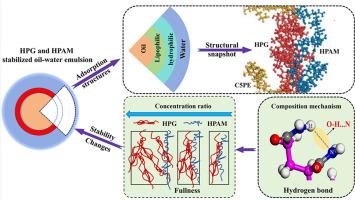Adsorption mechanism of polymers at the oil-water interfacial film and its effect on interfacial stability
IF 4.6
0 ENERGY & FUELS
引用次数: 0
Abstract
The efficient treatment of oilfield produced water is a key link to realize the green and sustainable development of oilfields, so it is of great significance to study the stability mechanism of oilfield produced water to realize the efficient treatment of oilfield produced water. In this paper, the stability of “fracturing return fluids”(i.e., multi-polymer emulsion systems) is used as a background for the study. Molecular dynamics simulation by constructing a sandwich model of oil/intermediate/aqueous phases with different components by varying the concentration ratio between polymers. Study on the effect of changing the concentration ratio between polymers on the stability of oil-water interfaces under polymerization system and the principle of its effect. The results showed that a clear oil-water interface was formed after the system was stabilized, and the thickness, structure, strength and hydrophilic adsorption layer fullness of the interfacial film were related to the concentration ratio between the polymers. The adsorption of Hydroxypropyl guar gum (HPG) and partially hydrolyzed polyacrylamide (HPAM) at the oil-water interface would form a double-layer membrane structure. The interfacial stability was the strongest when the ratio of the concentration of HPG and HPAM reached 2:1.The different polymer concentrations altered the thickness, structure, strength, and hydrophilic adsorbent layer fullness of the interfacial, which in turn affected the stability of the system.

聚合物在油水界面膜上的吸附机理及其对界面稳定性的影响
油田采出水的高效处理是实现油田绿色可持续发展的关键环节,因此研究油田采出水的稳定机理对实现油田采出水的高效处理具有重要意义。本文研究了压裂返液(即压裂返液)的稳定性。以多聚乳液体系为研究背景。通过改变聚合物之间的浓度比,建立不同组分的油/中间/水相夹层模型,进行分子动力学模拟。研究了聚合体系下改变聚合物间浓度比对油水界面稳定性的影响及其作用原理。结果表明:体系稳定后形成了清晰的油水界面,界面膜的厚度、结构、强度和亲水性吸附层的丰满度与聚合物之间的浓度比有关。羟丙基瓜尔胶(HPG)和部分水解的聚丙烯酰胺(HPAM)在油水界面处吸附形成双层膜结构。当HPG与HPAM的浓度比达到2:1时,界面稳定性最强。不同的聚合物浓度改变了界面的厚度、结构、强度和亲水性吸附剂层的丰满度,从而影响了体系的稳定性。
本文章由计算机程序翻译,如有差异,请以英文原文为准。
求助全文
约1分钟内获得全文
求助全文

 求助内容:
求助内容: 应助结果提醒方式:
应助结果提醒方式:


